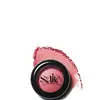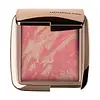What's inside
What's inside
 Key Ingredients
Key Ingredients

 Benefits
Benefits

No benefits
 Concerns
Concerns

 Ingredients Side-by-side
Ingredients Side-by-side

Mica
Cosmetic ColorantSynthetic Fluorphlogopite
Kaolin
AbrasiveSqualane
EmollientJojoba Esters
EmollientOctyldodecanol
EmollientHectorite
AbsorbentSilica
AbrasiveEthylhexylglycerin
Skin ConditioningPotassium Sorbate
PreservativeAlumina
AbrasiveBoron Nitride
AbsorbentCellulose
AbsorbentGlycerin
HumectantSodium Acetylated Hyaluronate
HumectantWater
Skin ConditioningTocopherol
AntioxidantGlycyrrhiza Glabra Root Extract
BleachingSodium Benzoate
MaskingCI 77891
Cosmetic ColorantIron Oxides
CI 77163
Cosmetic ColorantCI 77007
Cosmetic ColorantCI 15850
Cosmetic ColorantCI 45410
Cosmetic ColorantMica, Synthetic Fluorphlogopite, Kaolin, Squalane, Jojoba Esters, Octyldodecanol, Hectorite, Silica, Ethylhexylglycerin, Potassium Sorbate, Alumina, Boron Nitride, Cellulose, Glycerin, Sodium Acetylated Hyaluronate, Water, Tocopherol, Glycyrrhiza Glabra Root Extract, Sodium Benzoate, CI 77891, Iron Oxides, CI 77163, CI 77007, CI 15850, CI 45410
Mica
Cosmetic ColorantSynthetic Fluorphlogopite
Boron Nitride
AbsorbentHdi/Trimethylol Hexyllactone Crosspolymer
Polymethyl Methacrylate
Octyldodecanol
EmollientBenzoic Acid
MaskingC13-14 Isoparaffin
EmollientDehydroacetic Acid
PreservativeDiamond Powder
AbrasiveDimethicone
EmollientEthylhexylglycerin
Skin ConditioningLaureth-7
EmulsifyingMagnesium Aluminum Silicate
AbsorbentPhenoxyethanol
PreservativePolyacrylamide
Polymethylsilsesquioxane
Potassium Sorbate
PreservativeSilica
AbrasiveSodium Dehydroacetate
PreservativeSorbic Acid
PreservativeSorbitan Sesquioleate
EmulsifyingTin Oxide
AbrasiveTrimethylsiloxysilicate
EmollientCI 15850
Cosmetic ColorantCI 16035
Cosmetic ColorantCI 75470
Cosmetic ColorantCI 77007
Cosmetic ColorantCI 77163
Cosmetic ColorantIron Oxides
CI 77891
Cosmetic ColorantMica, Synthetic Fluorphlogopite, Boron Nitride, Hdi/Trimethylol Hexyllactone Crosspolymer, Polymethyl Methacrylate, Octyldodecanol, Benzoic Acid, C13-14 Isoparaffin, Dehydroacetic Acid, Diamond Powder, Dimethicone, Ethylhexylglycerin, Laureth-7, Magnesium Aluminum Silicate, Phenoxyethanol, Polyacrylamide, Polymethylsilsesquioxane, Potassium Sorbate, Silica, Sodium Dehydroacetate, Sorbic Acid, Sorbitan Sesquioleate, Tin Oxide, Trimethylsiloxysilicate, CI 15850, CI 16035, CI 75470, CI 77007, CI 77163, Iron Oxides, CI 77891
 Reviews
Reviews

Ingredients Explained
These ingredients are found in both products.
Ingredients higher up in an ingredient list are typically present in a larger amount.
Boron Nitride is compound consisting of boron and nitrogen. It is used to absorb oil and modify adherence/ slip in products.
This means it is often used in makeup products to help them last longer.
Ci 15850 is the pigment color red. It is an azo dye and created synthetically.
Azo dyes need to be thoroughly purified before use. This allows them to be more stable and longer-lasting.
This ingredient is common in foundations, lipsticks, and blushes. This color is described as brown/orangey red.
It has many secondary names such as Red 6 and Red 7. According to a manufacturer, Red 6 usually contains aluminum.
Learn more about CI 15850This pigment is called Ultramarine blue lazurite. It gives a saturated blue color, but can be used to create other colors as well.
According to the manufacturer, it is usually made from kaolin, sodium sulfate, sodium carbonate, sulfur, and charcoal.
This synthetic powder is used to add a pearly/white color in cosmetics.
Ci 77891 is a white pigment from Titanium dioxide. It is naturally found in minerals such as rutile and ilmenite.
It's main function is to add a white color to cosmetics. It can also be mixed with other colors to create different shades.
Ci 77891 is commonly found in sunscreens due to its ability to block UV rays.
Learn more about CI 77891Ethylhexylglycerin (we can't pronounce this either) is commonly used as a preservative and skin softener. It is derived from glyceryl.
You might see Ethylhexylglycerin often paired with other preservatives such as phenoxyethanol. Ethylhexylglycerin has been found to increase the effectiveness of these other preservatives.
Mica is a naturally occurring mineral used to add shimmer and color in cosmetics. It can also help improve the texture of a product or give it an opaque, white/silver color.
Serecite is the name for very fine but ragged grains of mica.
This ingredient is often coated with metal oxides like titanium dioxide. Trace amounts of heavy metals may be found in mica, but these metals are not harmful in our personal products.
Mica has been used since prehistoric times throughout the world. Ancient Egyptian, Indian, Greek, Roman, Aztec, and Chinese civilizations have used mica.
Learn more about MicaOctyldodecanol is a fatty alcohol. It is primarily used to enhance the texture of products.
As an emulsifier, Octyldodecanol helps prevent the oils and waters from separating. It also prevents ingredients from creating foam when shaken.
Octyldodecanol is created by reducing fatty acid to an alcohol.
Due to its high molecular weight, it does not get absorbed into the skin.
Learn more about OctyldodecanolPotassium Sorbate is a preservative used to prevent yeast and mold in products. It is commonly found in both cosmetic and food products.
This ingredient comes from potassium salt derived from sorbic acid. Sorbic acid is a natural antibiotic and effective against fungus.
Both potassium sorbate and sorbic acid can be found in baked goods, cheeses, dried meats, dried fruit, ice cream, pickles, wine, yogurt, and more.
You'll often find this ingredient used with other preservatives.
Learn more about Potassium SorbateSilica, also known as silicon dioxide, is a naturally occurring mineral. It is used as a fine, spherical, and porous powder in cosmetics.
Though it has exfoliant properties, the function of silica varies depending on the product.
The unique structure of silica enhances the spreadability and adds smoothness, making it a great texture enhancer.
It is also used as an active carrier, emulsifier, and mattifier due to its ability to absorb excess oil.
In some products, tiny microneedles called spicules are made from silica or hydrolyzed sponge. When you rub them in, they lightly polish away dead skin layers and enhance the penetration of active ingredients.
Learn more about SilicaSynthetic Fluorphlogopite is the synthethic version of mica. It consists of fluorine, aluminum and silicate.
Synthetic Fluorphlogopite is used to add volume to products.
It is considered non-irritating on the skin.
Learn more about Synthetic FluorphlogopiteThis ingredient is a combination of red, black, and yellow iron oxide pigments. This combination of colors is usually found in foundation, because it results in a "skin" color.